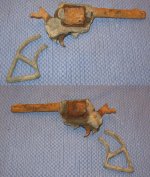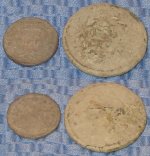Narthoniel
Bronze Member
Hello,
I came by some killer finds today, but I need some help with advice on how to clean and preserve them. The first object is a handgun of unknown age. I found the handle 15 feet from the gun - the plow must have done a number on it. The trigger guard is also missing, and I plan to go look for it later. I have been told by a friend that electrolysis is a good method for cleaning such objects, and I have used it on a small scale with success. But that was for silver coins and jewelry, would that be as good for this? And if so, is the process the same? Glass container, water, salt, lemon juice, and the conductor?

The second object is a large cent. There appears to be a thin layer packed onto both sides of the coin. Could I wet the coin and pick it away with a toothpick? Or would that be a big no-no? This is my first LC, so I have no clue how to go about cleaning such a find. I am new to the dirt in general to be honest, So there is a lot for me to learn yet.
The dime in the photo seems to be stained. I have not scrubbed or rubbed or used any cleaner on it, and do not want to do so without an idea of what works. Is the stain a permanent feature? Do I risk killing the value by trying to clean it a little?

Thank you in advance for any advice or suggestions. I appreciate any input or feedback you wish to impart. I do not want to harm any of these objects, so I am hoping to get a good idea beforehand of what works, and try it on a less valuable object first.
Thank you,
Anthony
I came by some killer finds today, but I need some help with advice on how to clean and preserve them. The first object is a handgun of unknown age. I found the handle 15 feet from the gun - the plow must have done a number on it. The trigger guard is also missing, and I plan to go look for it later. I have been told by a friend that electrolysis is a good method for cleaning such objects, and I have used it on a small scale with success. But that was for silver coins and jewelry, would that be as good for this? And if so, is the process the same? Glass container, water, salt, lemon juice, and the conductor?

The second object is a large cent. There appears to be a thin layer packed onto both sides of the coin. Could I wet the coin and pick it away with a toothpick? Or would that be a big no-no? This is my first LC, so I have no clue how to go about cleaning such a find. I am new to the dirt in general to be honest, So there is a lot for me to learn yet.
The dime in the photo seems to be stained. I have not scrubbed or rubbed or used any cleaner on it, and do not want to do so without an idea of what works. Is the stain a permanent feature? Do I risk killing the value by trying to clean it a little?

Thank you in advance for any advice or suggestions. I appreciate any input or feedback you wish to impart. I do not want to harm any of these objects, so I am hoping to get a good idea beforehand of what works, and try it on a less valuable object first.
Thank you,
Anthony




 .
.








